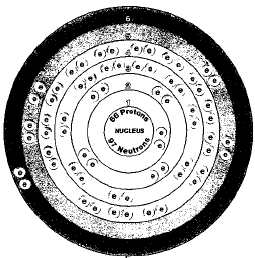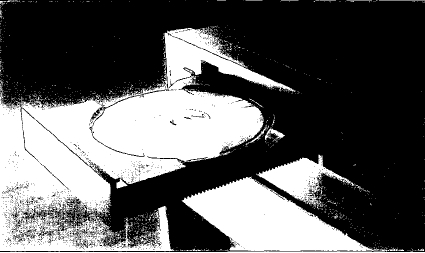DYSPROSIUM

Overview
Dysprosium is one of 15 rare earth elements. The name rare earth is misleading because the elements in this group are not especially uncommon. However, they often occur together in the earth and are difficult to separate from each other. A better name for the rare earth elements is lanthanides. This name comes from the element lanthanum , which is sometimes considered part of the lanthanides group in the periodic table. The periodic table is a chart that shows how chemical elements are related to one another.
Dysprosium was discovered in 1886, but was not commercially available until after 1950. The reason for the long delay was that methods for separating dysprosium from other lanthanides had not been developed. Dysprosium has relatively few applications today.
SYMBOL
Dy
ATOMIC NUMBER
66
ATOMIC MASS
162.50
FAMILY
Lanthanide
(rare earth metal)
PRONUNCIATION
dis-PRO-zee-um
Discovery and naming
In 1787, Carl Axel Arrhenius (1757-1824), a Swedish army officer and amateur mineralogist, found a rock in a mine at Ytterby, a region near Stockholm. He named the rock ytterite. A few years later, the rock was analyzed by Johan Gadolin (1760-1852), a professor of chemistry at the University of Abo in Finland, who found that the rock contained a new kind of "earth," which a colleague called yttria.
The term "earth" in mineralogy refers to a naturally-occurring form of an element, usually an oxide. For example, one kind of earth is magnesia, a term that refers to magnesium oxide. Magnesium oxide is one form in which the element magnesium occurs naturally in the earth.
The discovery by Arrhenius and Gadolin initiated a long series of experiments on yttria. These experiments produced puzzling results for two reasons. First, it turned out that yttria is actually a mixture of many similar elements. Second, the equipment that chemists had to work with was still very primitive. They had serious difficulties separating these elements from each other.
Over a period of more than a century, chemists argued about the composition of yttria. Eventually, chemists agreed that yttria is actually a combination of nine different elements that had not been seen before. One of those elements is dysprosium. Dysprosium was finally proved to be a new element in 1886 by French chemist Paul-Emile Lecoq de Boisbaudran (1838-1912). The name chosen for this new element comes from the Greek word meaning "difficult to obtain."
Physical properties
Dysprosium has a metallic appearance with a shiny silver luster. The metal is so soft it is easily cut with a knife. It has a melting point of 1,407°C (2,565°F) and a boiling point of about 2,300°C (about 4,200°F). The density is 8.54 grams per cubic centimeter.
Chemical properties
Dysprosium is relatively unreactive at room temperatures. It does not
oxidize very rapidly when exposed to the air. It does react with both
dilute and concentrated acids, however. For example, it reacts with
hydrochloric acid to form dysprosium trichloride.
Occurrence in nature
More than 100 minerals are known to contain one or more of the rare lanthanides. Only two of these minerals, monazite and bastnasite, are commercially important. These minerals occur in North and South Carolina, Idaho, Colorado, and Montana in the United States, and in Australia, Brazil, Canada, and India.
Experts estimate that no more than about 8.5 parts per million of dysprosium occur in the Earth's crust. That makes the element more common than better known elements such as bromine, tin, and arsenic. Studies of stony meteorites have found about 0.3 parts per million of dysprosium.
Isotopes
Seven naturally occurring isotopes of dysprosium are known. Isotopes are two or more forms of an element. Isotopes differ from each other according to their mass number. The number written to the right of the element's name is the mass number. The mass number represents the number of protons plus neutrons in the nucleus of an atom of the element. The number of protons determines the element, but the number of neutrons in the atom of any one element can vary. Each variation is an isotope. The four most abundant isotopes of dysprosium are dysprosium-161, dysprosium-162, dysprosium-163, and dysprosium-164.
At least eight radioactive isotopes of dysprosium have been made. A radioactive isotope is one that is unstable, gives off radiation, and breaks down to form a new isotope. Of these eight isotopes, only one, dysprosium-166, has much commercial importance.
The radioactive isotope dysprosium-165 is also being studied for some potential applications in medicine. Radiation with dysprosium-165 has proved to be more effective in treating damaged joints than traditional surgery.
Extraction
The dysprosium in monazite and bastnasite is first converted to dysprosium
trifluoride (DyF
3
). The compound then reacts with calcium metal to obtain pure dysprosium:
Dysprosium comes from the Greek word for "difficult to obtain."
Uses
Dysprosium has a tendency to soak up neutrons, which are tiny particles that occur in atoms and are produced in nuclear reactions.

Dysprosium is also used to make alloys for various electrical and electronic devices. An alloy is made by melting and mixing two or more metals. The mixture has properties different than any of the elements. Some dysprosium alloys have very good magnetic properties that make them useful in CD players.
Compounds
Like the element itself, some compounds of dysprosium are used in nuclear reactors and the manufacture of electrical and electronic equipment.
Radiation with dysprosium-165 has proved to be more effective in treating damaged joints than traditional surgery.
Health effects
Very little is known about the health effects of dysprosium.
Comment about this article, ask questions, or add new information about this topic: